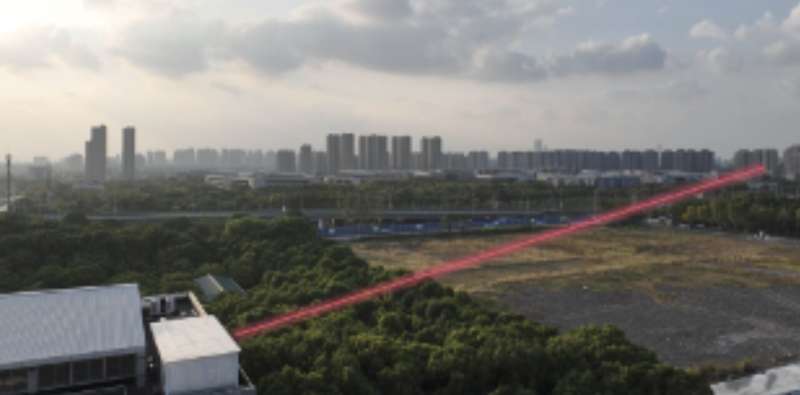
Intensity interferometry is an innovative method that offers detailed measurements of spatial characteristics like distances, shapes, and light properties by analyzing variations in light brightness rather than the precise timing of light waves, as seen in traditional amplitude interferometry. This new approach has advantages over older methods, particularly in its reduced sensitivity to atmospheric disturbances and optical flaws.
Though intensity interferometry shows promise for accurate image reconstruction, it typically depends on thermal light, which has various wavelengths, can contain only a few photons per measurement, and often diverges quickly. This has limited long-distance effectiveness.
Researchers from the University of Science and Technology of China, along with other institutions, have recently developed a groundbreaking approach to active intensity interferometry that allows for capturing high-definition images from distances exceeding 1 km. Their findings, detailed in a paper published in Physical Review Letters, showcase the capability to optically image small objects from 1.36 km away.
“Our recent paper is inspired by the groundbreaking work of Hanbury Brown and Twiss in the 1950s, who first utilized intensity interferometry to observe Sirius, a bright star,” shared Qiang Zhang, a co-author of the study, with Tech Xplore.
“This technique is not affected by atmospheric turbulence or telescope imperfections, providing unique advantages for long-distance optical imaging with high angular resolution. However, traditional intensity interferometry has mainly been limited to observing bright celestial objects.”
In their research, Zhang and his team aimed to boost the effectiveness of intensity interferometry, taking advantage of recent advancements in LiDAR technology. They merged intensity interferometry with active lighting, allowing them to capture detailed images of distant objects.
“Our active intensity interferometry concept includes two key components: an active illumination system and a receiving system,” explained Zhang. “The illumination system utilizes an array of laser beams. As these lasers navigate various atmospheric paths, their phases become random and independent, imitating the characteristics of thermal light from stars, which we refer to as ‘pseudo-thermal’ illumination.”
The other critical part of their method is the receiving system, an adaptable intensity interferometer designed to gather substantial spatial frequency information about the target.
“For the pseudo-thermally lit target, we monitor tiny intensity variations at two different detectors and correlate them over time,” said Zhang. “This data provides insight into the target’s spatial structure—the modulus of its Fourier transform—allowing us to computationally create a high-resolution image. This is the essence of optical synthetic aperture imaging using intensity correlations.”
The active intensity interferometry technique developed by this research team demonstrates significant advantages over earlier methods, achieving exceptional imaging resolution even in realistic atmospheric conditions over distances of kilometers.
To explore their approach’s potential, Zhang and his colleagues constructed both the active illumination and receiving systems. They performed imaging experiments on 2D double-slit patterns and letter designs, standard objects used for testing optical technique resolution.
“We successfully attained millimeter-level resolution from 1.36 kilometers,” noted Zhang. “The experimental results, as published in the PRL paper, clearly highlight the high-resolution capability of our method.”
Overall, this research shows promise, with their multi-laser system effectively addressing the limitations of pseudo-thermal light sources used by many current intensity interferometers, which often suffer from large divergence angles, hindering long-distance effective illumination.
“We also illustrated both theoretically and through experiments that increasing the number of laser emitters within the active illumination setup helps the pseudo-thermal light behavior mimic that of ideal thermal light,” said Zhang. “This is significant because better alignment with ideal thermal light translates to a stronger signal-to-noise ratio in intensity measurements, thus enhancing image quality.”
The findings by Zhang and his team could pave the way for more precise imaging of small objects over long distances and set a promising course for refining intensity interferometers.
“By continuing to develop and expand multi-laser systems like the one described in our paper, future active intensity interferometers can become even more resilient and efficient, making them more practical for various high-resolution, long-range imaging tasks,” Zhang added.
“In our upcoming studies, we intend to extend our method to capture high-resolution images of more complex shapes and even three-dimensional objects, while also focusing on practical applications of intensity interferometers in specific fields such as astronomy.”
More information:
Lu-Chuan Liu et al, Active Optical Intensity Interferometry, Physical Review Letters (2025). DOI: 10.1103/PhysRevLett.134.180201.
If you would like to see similar Tech posts like this, click here & share this article with your friends!

